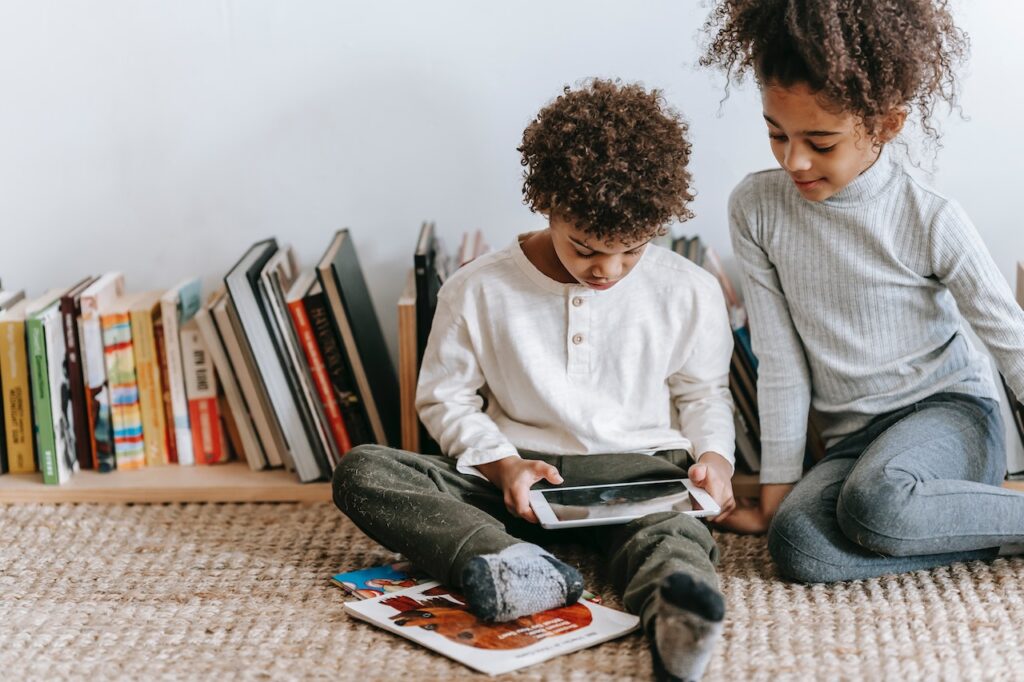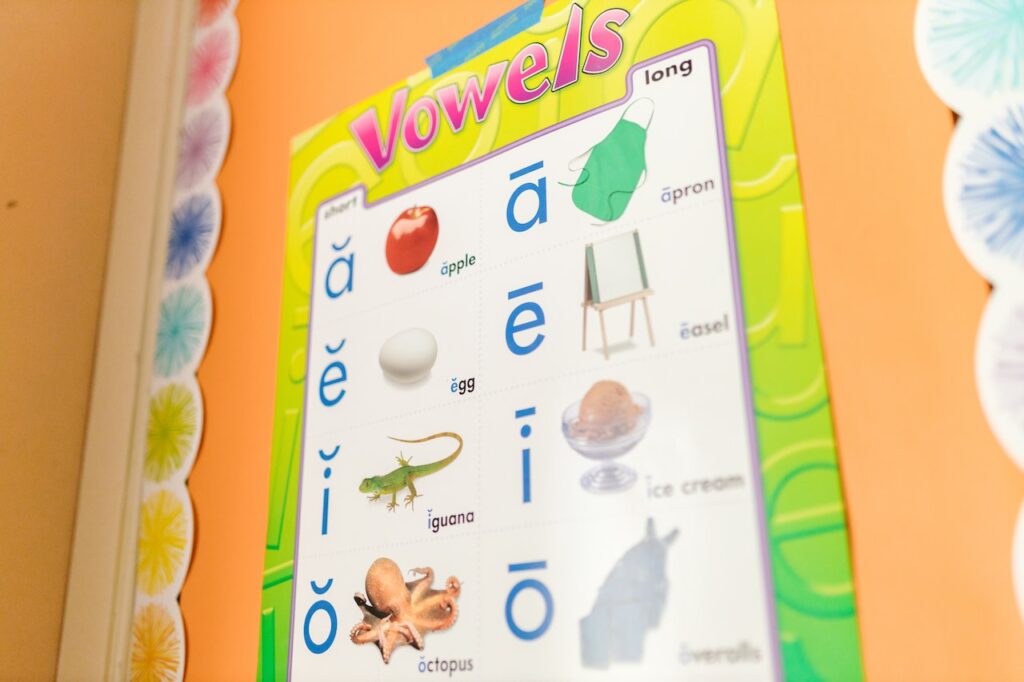
Learning how to decode words is crucial for developing early reading skills and guiding children to be fluent and proficient readers. Decoding relies on identifying and mastering sound blends, letter patterns, and learning the isolated sound(s) of each individual letter in the alphabet.
More schools are embracing the Science of Reading; this literacy strategy relies on a core curriculum of phonics. Learning phonics skills at an early age ensures children learn the strategies they need to identify, decipher, and understand any word. Phonics skills can start early; in fact, the best phonics apps for kids prepare children for kindergarten phonics lessons. Even older children can benefit from these instructive, fun and immersive apps!
How to Decode Phonics Apps for Kids
Not every app is a good fit for every child. How do parents find the ideal phonics apps to help an emerging reader? Thankfully, both Apple’s App Store and Google Play include recommended ages for each app in the store.
However, an app that can be used for a child 4 and older might be too simple for a child that is a bit more fluent with phonics than a preschooler. For this reason, parents also need to research and identify the features of the app.
Some apps are designed with immersive gamification. Some children prefer to learn via a platform that is designed like a game. Parents could prefer a standard learning app, however.
The best learning apps offer leveled lessons. For example, parents can choose lessons sorted by grade level, age, or even proficiency. Look deeper at what the app features and teaches.
How Much Do the Best Phonics Apps for Kids Cost?
Inflation has hit many households hard. The prices of goods and services often leave adults with sticker shock. Are phonics apps affordable?
Parents might be thrilled to find that phonics apps are free to download. Look closer, though, and be cautious when assuming an app is ‘free.’’ While downloading the app could be free, many apps let children or users purchase items and features in the game. These ‘extras’ are known as in-app purchases and they can add up quickly.
The App Store and Google Play denote when an app offers in-app purchases. Parents who want to ensure their child cannot make any unauthorized charges when playing their lesson-based game can take measures to disable the in-app purchases.
Apple provides a quick tutorial on how to disable purchases on the company’s devices. Parents with Android devices can check out the Digital Trends tutorial on disabling purchases via these devices.

The Best Phonic App for Kids Engages Children
Some free apps are just plain flops. Not every app is designed well or offers helpful instruction to children. Free apps are free, and the benefit of this no-cost download is that parents aren’t financially penalized when they want to explore the app before allowing their child to use it.
Download the app, disable the in-app purchase option, then explore the features and capabilities. How is it designed? Do the functionalities work? Is the app fun to use? While adults won’t have the same interest level as their child, exploring the app and previewing it can help parents understand if the app is a winner or if it needs to be deleted.
Some free apps are incredibly engaging. These apps could include simple games for children to begin to learn the alphabet and the sounds of each letter. Using the app also helps parents identify if the app is appropriate for their child. An older student who needs more exposure to phonics will not want to use the same type of apps or play the same games as a kindergartener. Consider the child’s age, maturity, and personality when test-driving an app.
Phonics for Kids App: Consider Under-the-Radar Apps
Not all apps are labeled as ‘phonics’ apps. While there are plenty of apps that teach children the sounds of letters and help children master the identification of each letter of the alphabet, helping a child with phonics does not have to include flash cards and matching games. Teaching children about sounds also can incorporate audiobooks.
Some older students struggle with phonics. Listening to a book read aloud and following the story in a standard book as they listen also is an impactful learning strategy. Apps like Audible offer subscriptions for parents to download and purchase audiobooks. In addition, Apple and other companies also provide access to these audio libraries.
Parents who need free resources also are in luck. Many public libraries let members request audiobooks, and they provide free access to a virtual bookshelf of audio titles.

Phonics for Kids Apps: Not All Kids Learn Best Via Gamification
Many free apps and popular apps for phonics and other core school subjects include gamification. While this type of app design increases engagement and interest, not every child loves the design. In addition, some children (and parents) find gamification distracting or discouraging.
Not all apps are gamified. However, more focused lesson-based apps might not be free. Apps designed with research-based lessons and structured content might require a subscription to use. Yet, apps created to instruct and guide phonics lessons enable children to gain proficiency and master the skills needed to decode words and read fluently.
These apps teach children how to sound out letters. In addition, they provide feedback when the child struggles. Instead of leading a child to play a game and perhaps ‘guessing’ an answer, lesson-based apps meaningfully instruct the child. These apps support reading success and help children feel more confident, too.
How to Find Lesson-Based Phonics Apps for Kids
Instructional apps that are designed to further advance the educational needs of a child are available via the App Store and Google Play. Parents don’t have to hunt for them in a vast list of other titles, and conducting a quick Google search that focuses on ‘instructional reading apps’ or ‘instructional phonic apps’ can help parents zero in on the best apps for their child.
Consider the skills with which a child is struggling. Does the child specifically struggle with sound blends and decoding? Maybe they also need help with reading comprehension. When children struggle with any reading skill, it’s essential for parents to find the best resources to help them.
Why Readability is the Best Phonics App for Kids
Readability is the ideal app to use for children who struggle with phonics skills. While many apps proclaim to be the best, Readability’s leveled design makes it adaptable as students move to higher grades. Readability is designed to be used from kindergarten through sixth grade.
Children gain access to a vast library of virtual books at each reading level in the program. They read these books aloud; however, they are not on their own as they read. Readability’s hallmark feature is an AI reading tutor that guides the lesson and learns each child’s voice. As the child reads stories aloud, the tutor intuitively knows when the child struggles. The tutor provides guidance, feedback, support, and encouragement.
Readability’s AI tutor also measures reading growth for each child. The tutor captures the child’s reading fluency with each book; fluency is measured in words read per minute. At the end of each book, the tutor also asks the child questions to test comprehension skills. If children demonstrate mastery of reading fluency and comprehension, they move to the next reading level.
Each book includes a list of vocabulary words. In addition, children can tap or click any word to hear the word read aloud or listen to it used in a sentence. Readability even includes a story reader function called Storytime–children can listen to all their favorite books in the app.
Parents who want to learn more about how Readability can help their child improve phonics skills, reading fluency, and reading confidence can explore the app for free. Sign up for a free seven-day trial and learn how Readability transforms the reading journey.

 Español
Español